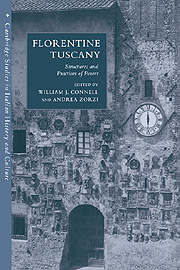Book contents
- Frontmatter
- Contents
- List of figures
- List of tables
- List of abbreviations of archival sources
- Introduction
- 1 The ‘material constitution’ of the Florentine dominion
- 2 The language of empire
- 3 Constitutional ambitions, legal realities and the Florentine state
- 4 Fiscality, politics and dominion in Florentine Tuscany at the end of the middle ages
- 5 Market structures
- 6 State-building, church reform and the politics of legitimacy in Florence, 1375–1460
- 7 The humanist citizen as provincial governor
- 8 Territorial offices and officeholders
- 9 Demography and the politics of fiscality
- 10 Florentines and the communities of the territorial state
- 11 Patronage and its role in government: the Florentine patriciate and Volterra
- 12 San Miniato al Tedesco: the evolution of the political class
- 13 The social classes of Colle Valdelsa and the formation of the dominion (fourteenth–sixteenth centuries)
- 14 Arezzo, the Medici and the Florentine regime
- 15 Rubrics and requests: statutory division and supra-communal clientage in Pistoia
- 16 A comment
- Index
- CAMBRIDGE STUDIES IN ITALIAN HISTORY AND CULTURE
6 - State-building, church reform and the politics of legitimacy in Florence, 1375–1460
Published online by Cambridge University Press: 16 September 2009
- Frontmatter
- Contents
- List of figures
- List of tables
- List of abbreviations of archival sources
- Introduction
- 1 The ‘material constitution’ of the Florentine dominion
- 2 The language of empire
- 3 Constitutional ambitions, legal realities and the Florentine state
- 4 Fiscality, politics and dominion in Florentine Tuscany at the end of the middle ages
- 5 Market structures
- 6 State-building, church reform and the politics of legitimacy in Florence, 1375–1460
- 7 The humanist citizen as provincial governor
- 8 Territorial offices and officeholders
- 9 Demography and the politics of fiscality
- 10 Florentines and the communities of the territorial state
- 11 Patronage and its role in government: the Florentine patriciate and Volterra
- 12 San Miniato al Tedesco: the evolution of the political class
- 13 The social classes of Colle Valdelsa and the formation of the dominion (fourteenth–sixteenth centuries)
- 14 Arezzo, the Medici and the Florentine regime
- 15 Rubrics and requests: statutory division and supra-communal clientage in Pistoia
- 16 A comment
- Index
- CAMBRIDGE STUDIES IN ITALIAN HISTORY AND CULTURE
Summary
Viewed over the span of a long fifteenth century, the histories of Florence, the papacy and the Florentine church align themselves into three distinct phases. First, the period of the papal schism corresponded to that of Florence's most rapid and extensive territorial expansion, and allowed the city's rulers to take the initiative in elaborating fiscal institutions, and a juridical apparatus, that circumscribed the operation of ecclesiastical institutions within their territory. The process reached its culmination in the codification of the city's Statuta (1415-18), and with the creation of its ‘catasto’ or tax inventory (1427). At the same time, such ‘state-building’ measures were complemented, and limited, by the policies of a governing reggimento which, shaken by the city's failed war of the ‘Eight Saints’ (1375-78) and the Ciompi revolt (1378) that framed the rupture of the papacy into schism (1378-1414), was also in the process of its own oligarchic consolidation. Rather than simply refurbish its old Guelf credentials, the regime deployed strategies aimed at appropriating directly the legitimating power of religion attaching to local ecclesiastical institutions.
Second, over the period from the resolution of the schism at the Council of Constance (1414-18) to the Medicean parlamento of 1458, and Pope Pius II's promulgation of the anti-conciliar bull Execrabilis (1460), while republican-minded Florentine oligarchs came to terms with the emergence of Roman-financed Medici power, popes from Martin V (1417–31) onwards moved to suppress the conciliar movement, to build a territorial base in Italy and to reassert ecclesiastical prerogatives throughout the peninsula.
- Type
- Chapter
- Information
- Florentine TuscanyStructures and Practices of Power, pp. 122 - 143Publisher: Cambridge University PressPrint publication year: 2000
- 2
- Cited by



